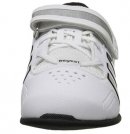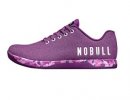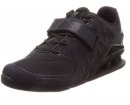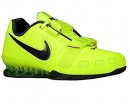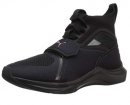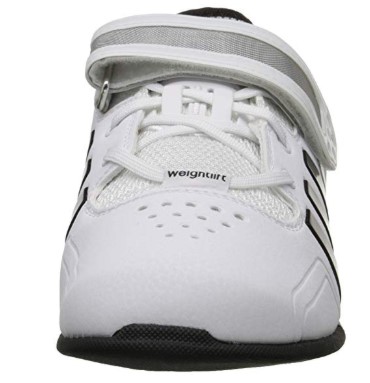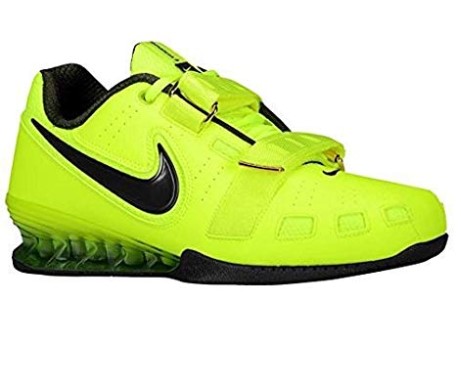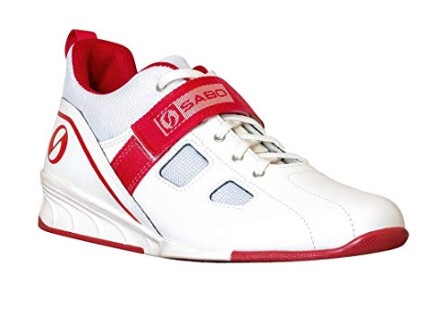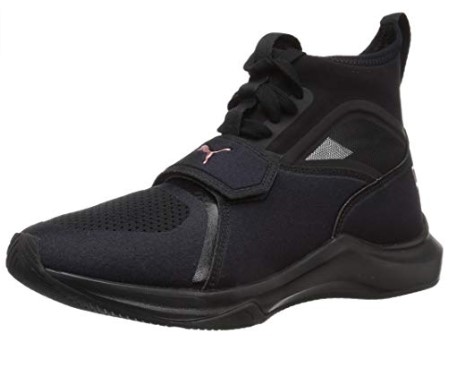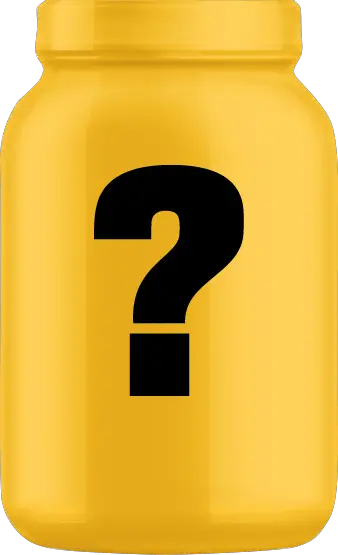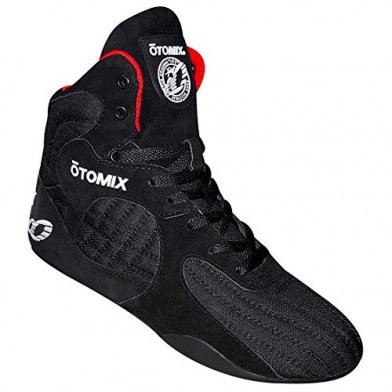Adipower vs Romaleos 2: Battle of the Weightlifting Shoes
Weightlifting is definitely a sport which is intense on your body. You are training and strengthening your muscles to their ultimate ability while being careful to protect them at the same time. So don't forget about your feet!
We are taking a look at the best shoes available for weightlifting, something that will be comfortable, supportive and help you distribute the weight correctly. Take a look at the top ten choices we found.
In a Hurry? The test winner after 266 hours of research

Raised heel for stability
Comes in a premium box
Sturdy velcro strap
Excellent stitching and lacing
10 Best Weightlifting Shoes
1. Nordic Power Lifting Shoes
Raised heel for stability
Comes in a premium box
Sturdy velcro strap
Excellent stitching and lacing
Run a little narrow
Nordic Power Lifting Shoes are a smart choice for your feet during your workout. They come in two different colors, blue or black, and they feature a 1.4 inch raised heel to help with your stability during your lift.
Read moreThe Nordic Powerlifting Shoes are premium shoes with maximum performance. They give Olympic status foot support so you have the stability you need for a great workout and gains in your lifting.
These shoes are built to last through the most intense workouts and stress and their warranty back up that promise. Powerlifting and anyone else working with heavy weight will appreciate how these shoes help them control their posture.
2. Adipower Weightlift Shoes
Comes in 3 colors
Adjustable instep strap
Non-stick rubber sole
Vent flow opening in outer sole
They run small
These shoes have been designed specifically for weightlifting and supporting heavy loads. They feature a leather collar and tongue and a strap which keeps the laces in check.
Read moreThe Adipower shoes are durable, made with leather with a rubber sole. The shaft measures low-top from the arch and it has a coated leather upper for maximum comfort and support.
It has a TPU midsole to help you keep a perfect foothold and a hook and loop instep strap which is adjustable for rearfoot integrity. The heel overlay gives you superb stability and this shoe has an anti-slip rubber sole.
3. Nobull Men's Training Shoes
Lightweight and flexible
Comes in 6 colors
Durable abrasion resistant material
Provides good traction and support
Run a little narrow
These shoes are lightweight, breathable and flexible so they are a good companion in your weightlifting routine. They have added protection on the sidewalls and a nice lug pattern designed for traction and support.
Read moreThese shoes have you covered not just for lifting but for many different sports. They are flexible, breathable and lightweight on your feet. They move with you.
The top of the shoe is one piece made of SuperFabric which is durable and abrasion resistant. The sole has a special lug pattern which is designed to go anywhere and provide traction and support.
4. Inov-8 Women's Weightlifting Shoe
1.25-inch heel
Adjustable instep strap
Padded collar and tongue
Good grip rubber sole
Run a little small
For women who are serious about their weightlifting experience, this shoe is the perfect fit. It has a 1.25-inch heel and a nylon ripstop upper portion. An adjustable instep strap and breathable material make it a truly comfortable shoe.
Read moreThe Inov-8 Precision Fit shoe helps you make gains a rep at a time. The shoe design was specifically influenced by weightlifting needs to give you the support, stability, and structure that you need in the mid-foot and heel.
These shoes are made with lightweight synthetic upper materials with laces and a strap which keeps the laces secure. They also have a plush collar and tongue. The breathable lining gives your feet a comfortable feel with a molded insole.
5. Reebok Men's Lifter
Comes in 7 colors
Rubber sole
Toe with leather
Anti-friction lining
Sizes run big
Reebok has always been a trusted brand in shoes. This one has a synthetic mesh upper with a rubber sole and leather on the toes. It has two hook and loop closures and a flexible grooved sole which is perfect for your workout.
Read moreThe Reebok lifter gives you the best stability platform for your lifting workout. The foot wrap is heat activated and molds to your foot so you have a customized shoe which does not need to be broken in. The dual strap closures keep the fit in place and the heel clips keep your foot secure.
The Reebok company was created specifically for athletes and their designs have been groundbreaking. With the synthetic and mesh upper coupled with an anti-friction lining, these shoes will keep you stable and help with your workout gains.
6. Nike Romaleos Weightlifting Shoes
Wide toe box
Nice stable heel
The heavier weight feels more stable
First rate design
Only comes in two colors
The original Romaleos was designed for the 2008 Olympics where it took center stage by helping the Chinese team dominate the WL medals count. Its offspring, the Romaleos 2, has been with us for a couple of years now and is a very worthy successor to its famous progenitor. With the Romaleos you’ll enjoy ironclad stability, remarkable flexibility when needed and the luxury of a changeable insole.
Read moreThe Romaleos has a superior design for weightlifting. It has dual lockdown straps to keep your laces in place and TPU heel for much better stability.
These shoes have a degree of customization. They also have a toe box which is wider which some lifters need because they have wider feet or their feet tend to spread out when they are lifting heavy loads.
When it comes to weightlifting Nike shoes you might want to learn how Romaleos compares to Metcon before making a final decision about your purchase.
7. Sabo Weightlifting Shoes
Made of durable synthetic leather
Flexible forefoot
Lightweight strong heel
Improved eyelet construction
They are not a brand name
Sabo made numerous improvements to these shoes in 2017. They improved the eyelet construction and made the metatarsal strap more durable. The overall design is more breathable and lighter with a flexible forefoot.
Read moreThe upper part of the shoe is durable, made of synthetic leather and nice breathable mesh. The Sabo Power Platform is a super modern and non-marking sole. The system has a more flexible forefoot and the heel is rock solid.
There is an instep strap which keeps your foot and ankle in your shoe firmly and the sleeves on the strap loop keep a tight lock. There is a heel made of plastic polymers which helps keep you feel more stable. It is lightweight but super strong and non-compressible.
8. Puma Women's Sneaker
Rubber sole
Comes in 7 colors
Has nice feminine detailing
Full-length flex groove
Does not have a lot of stretch
The Puma shoes are 100 percent synthetic with a rubber sole. The shaft measures about mid-top from the arch. These are high-performance shoes.
Read moreThe Puma boasts mixes fashion with true performance benefits. The upper is lined with their signature strap that is finished in feminine detailing. The high top stands out when you see it and also gives you added ankle support. It has a mesh insert which adds breathability.
The tooling gives you a full-length flex groove for movement in any direction and the special foam gives a superior energy return. This is a training shoe designed for high intensity.
9. Otomix Women's Stingray
Come in 12 stylish colors
Thin rubber sole with good grip
Lightweight and durable
Extra ankle support
Hard to find the right size
The Otomix weightlifting shoes are extremely durable and lightweight with a rubber sole. It is made of leather and synthetic material with a thin sole that has a good grip and excellent ankle support. They are perfect for weightlifting and bodybuilding.
Read moreThese are the original flat soled shoes for weightlifting and bodybuilding. These shoes are super lightweight and give your body support stability and support, as well as an unlimited range of motion.
It is feather light with great traction which is what you need for competition. It also comes in 1/2 sizes so you can get the perfect fit.
10. RXN Power Lifting Shoes
Made of natural leather
Crepe rubber sole for good stability
Elevated heel for good stability
Unisex shoe sizing
Not washable
The RXN shoes have a full leather upper and a crepe rubber sole which give them better stability. There are adjustable hook and loop fasteners for the best foot integrity.
Read moreThe RXN natural leather upper offers comfort and better durability. The crepe rubber sole will give you stability and better results during your lifting workout. There is an adjustable instep strap which will give your rear foot more integrity. The elevated heel gives better stability during your lifts.
Criteria Used for Evaluation

Effectiveness
If you ever went lifting without actually having weightlifting shoes on, it's most probable that you didn't feel any issues, and are now left wondering why should you even buy weightlifting shoes in the first place. Well, we are here to tell you that although you can safely lift in regular shoes, say Chuck Taylor's or running shoes, you will have a much better time when you lift in shoes actually made for that particular purpose.
Weightlifting shoes have many benefits to offer you, and they do quite an effective job at making you lift better. You've probably seen these shoes before when you went to the gym. These shoes are also known as Oly shoes, and if you are not familiar with them, you might think that they are some sort of odd shoes with weird big wedges. How can wearing such a shoe help you in any way? Well, experienced lifters and athletes all agree that they are a beneficial part of weightlifting, and that you really need to invest in a pair if you want to lift the best possible way.
But, if you do not want to significantly improve your weightlifting, and are only doing it casually, not wanting to grow any serious muscle, then you probably don't need a pair of weightlifting footwear in the first place. But if you lift religiously and with good, proper form and movement, and want to feel all of those lovely benefits of lifting, then by all means purchase a good pair! The shoes can also help you even if you are a beginner, you do not need to earn the right to wear them.
So, what do these shoes exactly do? Do not imagine that you will magically be stronger and more fit when you put on a pair. The sneakers have a special lifted heel, that increases the range of motion of our ankles. This means that if you struggle with squats, as an example, you will be able to squat deeper and achieve perfect form. Also, they will allow you hips to flex and extended during every Olympic movement. This means that they let you move through the whole motion needed to lift particularly heavy weights. The shoes can also help you overcome lifting heavier weights. This works because the heels of the shoes give you stable ground to push up against, generating more power as a result. Footwear that has cushions in it, like running shoes, make your feet sink into the soles and do not give you stable, firm ground. But keep in mind that weightlifting shoes are for weightlifting only, and nothing more. For example, you shouldn't do deadlifts in weightlifting shoes. This is because the shoes lift your heels, making you pull the bar from a further distance, so you'll have a harder time lifting it off the ground. But then again, some people purposely do this to help them become even stronger when deadlifting. If you do not now what you are doing, do not attempt to deadlift this way unless you have someone more experienced guide you through the motions.
If you do more than just lift when you workout, then a crossover shoe that can benefit every movement you could possibly think of would be the best for your needs. But if you lift and nothing else, then get yourself a pair and see for yourself how effective they can be!

Comfort
Comfort is important because you want to be able to focus on your workout without worrying about foot injuries or dealing with blisters. Be sure you have the perfect size which will tuck around your feet and protect them while you are exercising.
As we mentioned before, do not expect that you weightlifting shoes will have any sort of cushioning. When you lift, cushioning is the last thing you need. When feet sink into the cushions, you need to use more effort to actually lift the weights, and that could be a potential problem because you could lose your proper form, and maybe even injure yourself. You should also make sure that your shoes are built properly. Any seams and stitches that you feel when putting on the shoes should be noted, and the shoe model should be discarded because those details could cause blisters and irritation. Also, make not of which material the shoes are made out of. Some will be soft right when you buy them, while most shoes will need to be broken in properly before you get to wear them normally. You should break in weightlifting shoes like you would break in any other pair of sneakers. First, walk in them around your house for a few hours, for two or three days, maybe even longer, or shorter, depending on how the shoes fit you. If they need to be stretched out even more, try putting in some newspaper until they are fully stretched, and then heat up the shoes with a hair dryer. Heat makes things expand! If not even that works, they get them to a cobbler - they are pros after all, and know just what your shoes need to stretch out!

Fit
Fit is real close to comfort. The shoes will not work well unless they are the right fit for your feet. If you have wide feet then make sure the shoes made way for that. If you have weak ankles, make sure they are high top and have plenty of ankle support. Make sure the shoes will keep your feet snug and supported in just the right way. This is just the shortened version, but if you need a guideline in choosing the correct fit for your feet, then head on down below.
How do you know that your shoes fit you perfectly when you're still in the store? Well, the first sign of a good fit is a snug fit. But not too snug! The perfect fit needs to hold onto your heels when you walk, while not squeezing and hurting your toes. There shouldn't be a lot of room between your toes and the front of the shoe either. There should be no more than 1/8-inches of room between whichever of your toes is the longest, and the end of the shoe. Your footwear needs to be wide enough for your feet as well. If you feel like your little finger is being crushed to death, and you can actually visibly see it protrude out of the shoe, it's time to go for a wider option. You shouldn't feel any pain or pinching when you walk around, even when you just buy the shoes. Yes, they will need to be broken in, but this shouldn't feel like stretching the shoe one number larger than it is. The feet shouldn't slide around your footwear when you move, and the closure system, be it laces or straps, must not squeeze you.
To make sure that you have the best possible fit, shop for the sneakers in the evening. This is when your feet will be at their largest thanks to swelling, and you do not risk feeling that the shoes are too tight around your feet when the night comes. If you bought leather sneakers, and they feel snugger than you'd like them to, but they are your size, give them a chance. Leather stretches a lot, and softens the more you use it, so they will eventually fit you to the tee. But if your pair is synthetic and it feels snug, you've bought the wrong size! Synthetic pairs will not stretch out. Make sure that you simulate lifting motions when you are just trying out the pair - this will give you an idea of what you need. Also, remember to wear socks! You won't be going to the gym barefoot.
One more thing to consider is the closure system. Most lifting shoes come with one strap. Some have two straps, making them more secure. The straps will hug your feet around the upper portion of the tongue. This strapping style gives your feet more security, allowing your ankles to move more without any injuries. Weightlifting shoes will never be simple slip-on, as they have a tendency to slip off, and do not feel so stable. The straps will keep your feet locked into place, preventing them from slipping out or moving around. This will make lifting easier and more secure. Velcro is usually what locks down your feet, although the hook and loop system can be seen too. Make sure that your lifting shoes strap you in firmly and securely!

Heel
Athletic shoes come in all shapes and sizes but most weightlifting shoes come with a bit of a heel. If this is something you need to help with stability and support while you are doing your lifting, then you will want to pay attention to this and find a shoe which the perfect size heel that is going to help your workout.
The heel height can vary greatly, but the standard height is .75". Still, some athletes like to put inserts in their shoes to make the heels even higher than this. As we said before, the heels help you reach greater squatting depth while keeping your torso upright. If you struggle to find the perfect heel height for you, there are some things you should consider before actually choosing your height.
The length of your legs and torso are two key factors when determining how high your heels need to be. Study your body in great detail and deduce whether your legs and torso are long or shirt. If you are unsure, ask a more experienced person or a coach for help. Sometimes, both the legs and torso can be long or short, or it can be a combination of both. If your legs are slender and long, you need a heel that is at least .75" or higher. Taller people need more effort to squat deeply with the proper form. If your legs are short, however, you will need less effort to achieve great squatting depth. Start with a .75" heel and work your way from there.
Now the torso length. A longer torso has the tendency to lean forward and curve, which is the last thing you need happening when you lift. If your legs are short but your torso is on the long side, then you can go for a shorter heel. If you are long in both areas, go for taller heels. A short torso makes it easy to stay upright at full depth. Long legs and a short torso need higher heels, while short everything can use whichever heel height they want!

Durability
Weightlifting is an intense rough workout and needs a shoe that can stand up to the challenge. Even if it costs a little extra, having a shoe that is going to last is worth the investment. Look for quality materials, excellent stitching and durable eyelets.
We will also let you know when should you start to think about buying a new pair. generally, you probably won't be using your weightlifting sneakers for anything else besides weightlifting, so it's unlikely that they will break down very fast. In fact, they may last longer than any kid of shoe you own! Yet, there are still some things to look out for if you are trying to figure out whether its time to say goodbye or not. If your shoes are starting to crack where the heel meets the shoe, or if the glue is coming off, then it's definitely time to search for a new pair. If they are still under warranty, consider sending them off to their manufacturer and ask for a replacement. Although a cracked heel may not influence your lifts right away, it could still be ineffective when you need to lift heavy weights. Let's switch our focus from the heel to the strap area. The straps are the security you need when you lift, and if they start to fall off you might as well get a new pair. Sometimes, the loop on the shoe can break, or the Velcro could start losing its grip. This is all something you can fix by a simple trip to the cobbler though. But make sure to let them know to make the strap tight!
Weightlifting shoes have something that shoe manufacturers refer to as a cemented construction, AKA stuck-on construction. This does look just like it sounds - it's just one layer of shoe piled onto a different layer, with some sort of glue between them that keeps them together. This makes sense when all things are considered, but when the glue starts to peel off the soles may detach, and what good is a shoe without its soles? Pay special attention to the inside of the shoes and the front, which is where moisture will likely build-up and cause problems. To make them last longer, use them just for lifting, and nothing else!
Check out shoe websites and buying guides. Keep in mind your goals and your body types and find the perfect shoe to fit them. Take your time choosing them since shoes are an important tool.
The correct heel height will vary depending on your body type, whether you have a long or short torso or legs. You will also want to consider how flexible your ankles are and how much support they will need.
Other Factors to Consider

Materials
What the heel of your weightlifting footwear is made out of will also impact your lifting, to a degree. The heel can be either made out of plastic, leather or wood. Plastic heels, made out of TPU, are the most common ones. they will give you a flat, sturdy surface to stand on, while being more durable than leather or wood at the same time. Their shape can also vary, coming in as either solid block or pillars. Wood heels are for you if you feel like going old school. It is generally believed that wood heels let you feel the floor underneath you, and they are commonly used by Olympic weightlifters. Leather heels are similar too wood heels, again giving you the old school vibe. The only problem with these heels is their weight, and their durability.

Bottom Line
If you are truly serious about weightlifting, and are constantly looking for ways to improve your performance, then weightlifting shoes are just what you need. These shoes are made specifically to let you be even better at what you love, and will push you to strive for even greater heights. They will never hinder your performance, but they shouldn't be used for anything else besides lifting, since they can actually be quite uncomfortable for walking, or running. We hope our guide has helped you understand weightlifting shoes better, nd that you now understand their true value and potential!
Frequently Asked Questions
q: What factors are important when choosing weightlifting shoes?
This is a very important question that everyone should ask themselves before buying a pair. The most important factors to consider include non-compressible soles, heel height, support, comfort, and fit. Of course, you can also look toward more minimal options to fill the role of weightlifting shoes. If you do not buy the proper shoe for your feet, you could actually hurt yourself, or at least hurt your performance. With that said, let’s learn how to choose weightlifting shoes already!
q: If my ankles are not really flexible or mobile, what type of heel is best for me?
Ankle mobility plays a major role in weightlifting. If your ankles are not on the mobile side, you might feel more pain when lifting, or have a harder time maintainig proper form and depth. You will want a heel on the higher side, like over three-quarters of an inch. These are also better if you have really long legs or a narrow stance.
q: How do I tell if I got the right fit?
If you have a shoe that fits correctly, you will have a snug heel with no lift. You want 1/8 inch between your toes and the toe of the shoe. There should be enough volume and width to house your feet with no discomfort, pain or loss of blood circulation. Your foot should not slide around in the shoe. Do not forget about breaking the shoes in! Leather footwear will feel more snug than what you're used to, but it will stretch out in time. Synthetic pairs will not stretch out, at all, so make sure that their fit does not bother you in any way when you first try them on.
q: Why should I use weightlifting shoes?
This is something many beginners ask themselves. Weightlifting sneakers can truly be an investment, and you could potentially spend lot of money on them, and why should you do that if you don't really need them? Trust us when we say that the pros know what they are doing, and that there is a reason these shoes exist. Although you could lift barefoot, in minimal shoes, or even in All-stars, you will still feel the most benefits when going for a weightlifting pair. Using a weightlifting shoe helps you get a better mechanical angle at the bottom of your squat position. They also make you feel more locked in, giving you are stability.
q: When should I use weightlifting shoes?
Whenever you feel ready to start lifting serious weight! Beginners can also buy them, there is no reason for that, but there are a few things to consider before going for weightlifting footwear. Make sure you can squat well, and that you can maintain the proper form and movements. This is very important because the shoes can't let you magically squat properly, you really need to learn that by yourself. If you are just learning to squat, you need to get used to the feel of the orientation of your body in that position. You need to learn to do it right before you can learn to do it well. If you are more advanced and want to be even better at lifting, then the time is right for you to buy a pair. You already probably own a pair if you are a pro, so there's no need to let you know when to buy a pair, unless you are not sure when to replace the shoes. We explained this in great detail in our durability section, so make sure to check it out!
Sources
- , How To Choose Workout Shoes, Article
- , What When Why Weightlifting Shoes, Blog
- , The Ultimate Guide to Lifting Shoes, Buying Guide
- , Tips for Choosing Weightlifting Shoes, Buying Guide
- , Weightlifting Shoes--A Buying Guide, Buying Guide













